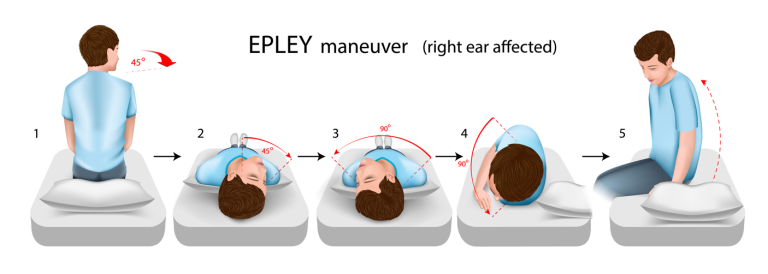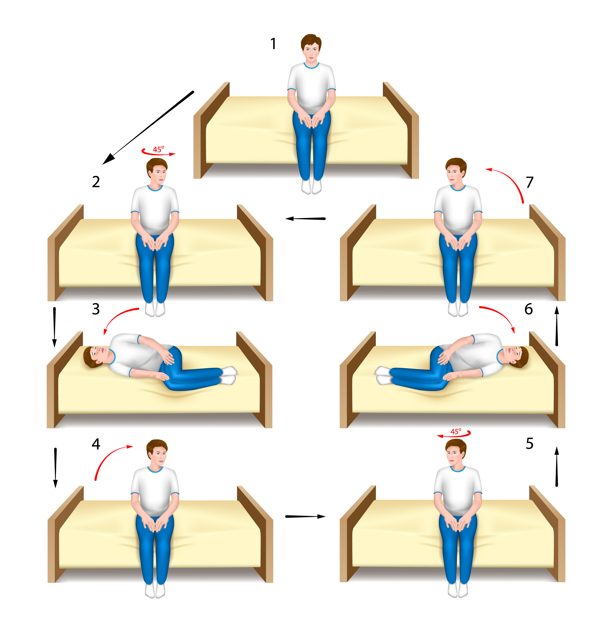
What to Do When You’re Dizzy, and How to Tell if You Need Medical Help
We don’t often talk about it, but there’s a lot of dizziness going around. One review study reported that dizziness is the second most common complaint among patients in a primary care setting—the most reported in patients older than 65. The National Institutes of Health (NIH) estimates that one in three of us will experience dizziness lasting more than a moment in our lifetimes. And almost all of us have experienced that lightheaded moment upon standing when our blood sugar or blood pressure is low.
That’s part of the problem. Dizziness is so common that it is hard to know when we should just wait for it to pass and when we should speak with a medical professional. So, we’re going to break it down for you and offer some information on what to do to alleviate dizziness so you can get on with your life. Most dizziness is uncomfortable but no cause for alarm. But sometimes, dizziness is an indication of a serious underlying condition.
First, let’s define our terms.
What is Dizziness?
Dizziness is feeling woozy or unsteady. Healthcare providers describe dizziness as having impaired or disturbed spatial orientation. You might describe dizziness as feeling wobbly or lightheaded. You may feel as if you need to sit down before you fall. Other ways of experiencing dizziness include feeling faint, nauseated, off-balance, disoriented, or confused.
Those symptoms sound vague and confusing, but if you take a minute to figure out exactly how you feel, it will be much easier to figure out the underlying cause of your dizziness. All cases of dizziness can be identified more precisely as one of four types: vertigo, disequilibrium, presyncope, or lightheadedness. If you understand which sensations go with which type of dizziness, you can take more focused actions to feel better, and, if necessary, quickly help a medical professional get to the root cause of your dizziness.
Vertigo is often used synonymously with dizziness, but it really is just a specific type of dizziness. Vertigo refers to the illusion of environmental motion, often described as the room spinning around you. The sense of motion is usually rotatory—like the feeling of getting off a merry-go-round—but it can be more linear—the ground tilting up and down, like being on a boat at sea. Disorientation in space and a sense of motion are common symptoms of vertigo.
Vertigo always reflects a problem, whether short or long-term, at some level of the vestibular system, otherwise known as your inner ear. The vestibular systems is responsible for your sense of balance, among other things. Meniere’s disease and a simple ear infection can both cause vertigo.
Disequilibrium makes you feel like you are not capable of walking successfully. Sometimes people suffering from disequilibrium think that their problem has something to do with their legs. Others immediately recognize it as a form of dizziness that affects their ability to walk. The bottom line is, you know your dizziness is disequilibrium if you’re pretty sure that walking is your problem, or walking makes your problem worse.
Disequilibrium can be caused by vestibular problems, like Meniere’s, but then would likely also include symptoms of vertigo. Otherwise, certain medications, a head injury, a previous case of meningitis, and certain degenerative neurological diseases can cause disequilibrium.
Presyncope (pre-sink-oh-pee) is the feeling that you are about to faint. It isn’t that easy to determine that your dizziness is presyncope if you have never actually fainted. Other symptoms of presyncope include feeling lightheaded (see below), weak, warm, sweaty, or nauseated. If you’re experiencing presyncope, you may appear confused or drunk, and have blurry vision and slurred speech. Your vision may go black or gray. Heart palpitations and stomach pains may also accompany presyncope. Presyncope is what you may feel when you stand up quickly after sitting for awhile.
Presyncope is generally caused by a reduction in the flow of oxygenated blood to the brain. And that can be caused by various heart-related ailments, including hypotension, as well as low blood sugar, dehydration, long-term bed rest, and some medications. Presyncope can also be caused by stress or shock.
Lightheadedness is very difficult to describe without using the word “dizzy,” but that’s not necessarily a bad thing. Lightheadedness is when you feel a dizzy sensation that is not vertigo, disequilibrium, or presyncope. If you are not feeling the room spin or rock, have no trouble walking, and don’t feel faint, you can describe your feeling as lightheadedness. Some people describe feeling “floaty,” “high,” or detached from their bodies.
Lightheadedness can be caused by many of the same things that cause presyncope, like hypotension, dehydration, low blood sugar, and stress. Other causes include anemia, anxiety, lack of sleep, heat exhaustion, and another list of medications. Lightheadedness without the other types of dizziness is most often associated with very temporary causes and the easiest type of dizziness to alleviate on your own.
What to Do if You’re Experiencing Dizziness
Obviously, the activities that mitigate dizziness will depend on what type of dizziness you are experiencing and the underlying cause of that dizziness.
- Your first step should be to really consider your symptoms and try to figure out what category your dizziness falls into.
- After that, consider the usual causes of that type of dizziness and try to figure out what might have caused yours. Have you experienced a head trauma? A sinus infection? A long day at the beach? Have you started a new medication? Restricted your calories? Experienced increased anxiety? The causes will give you clues to how to make yourself feel better.
- If you’ve identified possible causes, try an appropriate, corresponding action (see below).
- If you aren’t clear on the type or cause, try the all-purpose method below.
An All-Purpose Dizziness Reducer
Lie down in a cool dark room. Put a cool compress, or a light towel over your eyes. Just closing them works too. Stay that way for 20-30 minutes. When you move again, move slowly. Repeat the process as often as necessary.
For Vestibular System-Related Dizziness (Vertigo or Disequilibrium)
There are two pretty simple exercises medical professionals recommend for dizziness related to inner ear issues: The Epley Maneuver and the Brandt-Daroff Maneuver. This is what they look like:

The way you do the Epley Maneuver will depend on which ear you believe is affected. If you’re not sure, try it both ways.
Epley Maneuver for Affected Right Ear
- Lie down on your back.
- Turn your head to the left for 1 minute.
- Turn your head to the right for 1 minute.
- Turn your whole body to the right, head facing towards the floor, for 1 minute.
- Sit up slowly, head tilted forward for 1 minute.
Epley Maneuver for Affected Left Ear
- Lie down on your back.
- Turn your head to the right for 1 minute.
- Turn your head to the left for 1 minute.
- Turn your whole body to the left, head facing towards the floor, for 1 minute.
- Sit up slowly, head tilted forward for 1 minute.
The Brandt-Daroff Maneuver
The Brandt-Daroff Maneuver is very similar to the Epley Maneuver except the initial head turns are done sitting up, then you immediately lie down on your side with your knees bent. Some experts say Brandt-Daroff can easily be done without a medical professional’s help. But try both and see what works for you.

For Presyncope and/or Lightheadedness
These are often situational or lifestyle-related, so some simple, common-sense actions can really help end a dizzy spell.
- Drink water.
- Eat a piece of fruit to raise your blood sugar, but not too quickly.
- Try a breathing exercise.
- Rest in a cool place if you are overheated.
- Take a nap.
Longer-term and preventative approaches include some therapeutic additions and lifestyle changes.
- Try acupuncture. The NIH reports that many sufferers have cured dizziness that way.
- Get more sleep.
- Avoid alcohol.
- Quit smoking.
- Move more.
It may not be exciting, but the best way to avoid dizziness is to adopt all the lifestyle changes that benefit us in so many other ways.
When Should You Contact a Healthcare Professional?
Dizziness is common and most cases do not indicate a serious underlying condition. But there are certain signs that you need to contact a medical provider.
- If your dizziness comes on suddenly and severely.
- If your dizziness doesn’t go away or keeps coming back.
- If your dizziness affects your ability to go about your day.
- If your dizziness began following any head trauma.
- If your dizzy symptoms occur in conjunction with any of the following:
- Sudden, severe headache
- Chest pains
- Shortness of breath
- Pain, pressure, heaviness, or tightness in the chest, shoulders, neck, arms, jaw, or back
- Loss of consciousness
The Bottom Line on Dizziness
There are four types of dizziness: vertigo, disequilibrium, presyncope and lightheadedness. Two of those are directly related to inner ear issues. Understanding which type you are experiencing will help you decide what steps to take to make yourself feel better.
Dizziness can often indicate that you are engaging in a few too many unhealthy habits. A few lifestyle changes will go a long way towards preventing future dizzy spells.
Most dizziness is more uncomfortable than dangerous. But you should definitely seek medical help if your dizziness comes on suddenly and severely, if it is connected to head trauma, if it doesn’t go away, or if it is accompanied by other alarming symptoms.